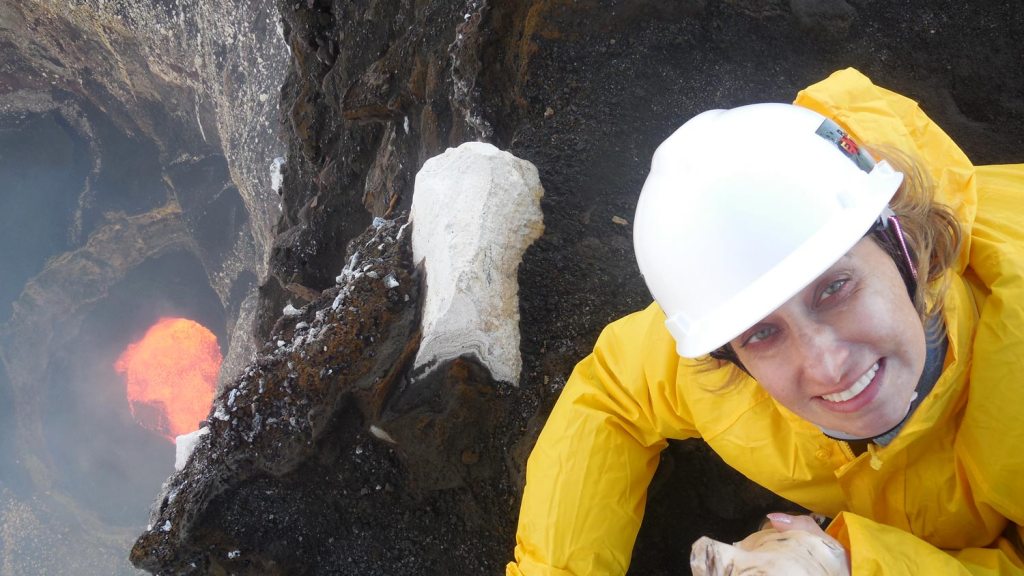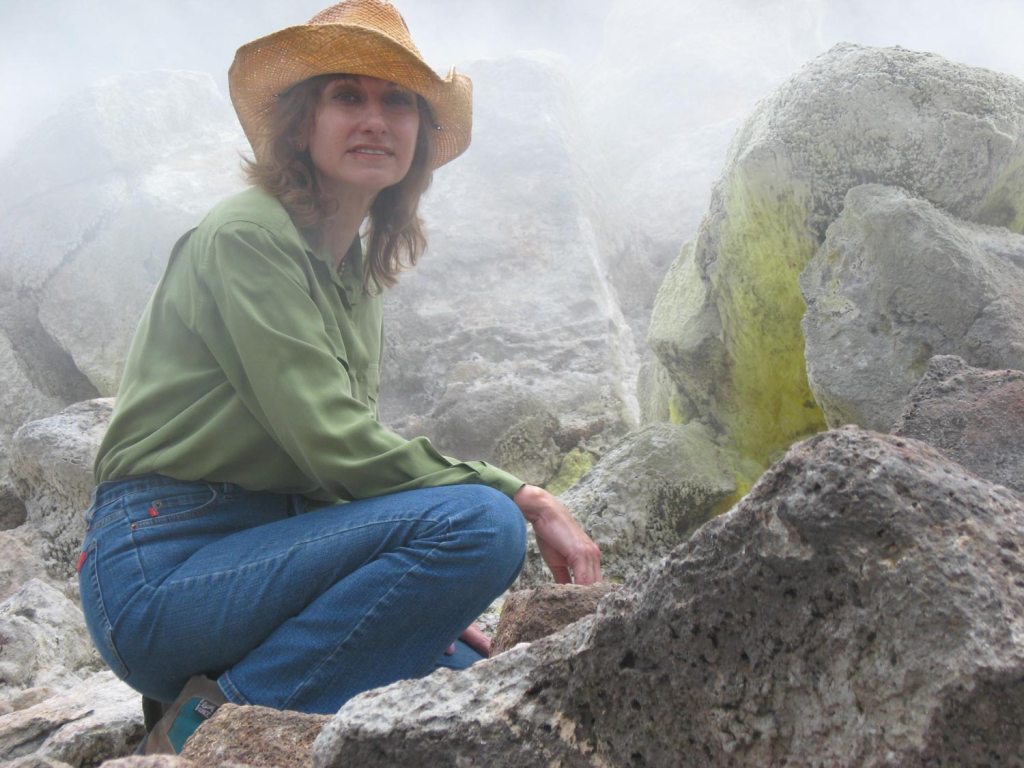Sure, the cone was pyroclastic—a technical term meaning “sometimes spews lava”—but it seemed to be done erupting. So Rosaly Lopes and her advisor proceeded with their fieldwork on Sicily’s temperamental Mount Etna.
It was 1981. Twenty-four-year-old Lopes, a graduate student in planetary geology at University College, University of London, and her thesis advisor, Dr. John Guest, were surveying a fresh basaltic lava flow field near one of the many cones on Etna’s flanks.
From within the cone came an almost cosmic roar—like a Sumatran tiger’s multiplied a millionfold. Lava spurted skyward. Someone observing from a distance might have seen Lopes silhouetted for an instant by a flare of incandescent fragments limned in orange and red.
We’ll return to this tableau—Lopes and Etna, the bright-eyed young scientist and the showboating volcano—in a moment, but first let’s talk Lopes and what she studies.

Volcanologist Dr. Rosaly Lopes is a senior research scientist at NASA’s Jet Propulsion Laboratory, former manager of the Planetary Science Section and an investigation scientist on the Cassini Titan Radar Mapper Team | Photo courtesy of Rosaly Lopes
The floor is super-lava
The REI Co-op Force of Nature initiative celebrates women outdoors. Lopes is definitely worth celebrating. To begin, she’s a senior scientist at NASA’s Jet Propulsion Laboratory and former manager of the Planetary Science Section. And, she’s an investigation scientist on the Cassini Titan Radar Mapper Team. Lopes has more accomplishments and accolades than this entire article could fit; her CV is 27 pages long.
Highlights of her career include studying volcanoes on every continent, discovering volcanoes in space, discovering ice volcanoes in space—yes, that’s a thing, and we’ll get to it shortly—penning books like The Volcano Adventure Guide and co-authoring works like Antarctica: Earth’s Own Ice World, and, now, doing research that could one day help us detect extraterrestrial life on the ocean moons of the outer solar system.
Fundamentals first. When you look at a celestial body like Earth or the moon or Mars, Lopes explained, what you’re seeing is an interplay between four major processes: volcanism, tectonism, impact craters and erosion. “Volcanism is one of the fundamental processes that shapes the surface of planets.”
But what is a volcano? Beneath your feet is the Earth’s rocky crust, which is no more than about 30 miles thick, depending on your location. The crust is like the chocolate coating on a candy bar—it’s what you see on the outside, but it’s just a thin layer. There’s a lot more going on underneath.
Below the crust, there’s the mantle, a layer of mostly solid rock roughly 1,800 miles thick, about the distance from Chicago to San Francisco. I say “mostly solid” because scattered throughout the mantle and crust are pockets of molten rock called magma. Magma that erupts through ruptures in the crust is called lava. The ruptures are called volcanoes.
Remember when you were a kid jumping from chair to couch because “the floor is lava” and your exasperated parents were like, no, the floor is not lava, stop monkeying around before you break something? Well, in a way, they were wrong and you were right.
Beneath the mantle, surrounding Earth’s solid inner core, is the gooey outer core, a layer of uber-pressurized liquid metal about 1,400 miles thick (Chicago to Salt Lake City), and almost as hot as the surface of the sun. To phrase it differently using a term I made up: Two-thousand miles under your feet, the floor is super-lava.

Dr. Lopes descends closer to the lava lake on Mt. Marum in the Pacific island nation of Vanuatu | Photo courtesy of Rosaly Lopes
Ice volcanoes in space
So, about those ice volcanoes.
“Cryovolcanism was first discovered by the Voyager spacecraft on Neptune’s moon Triton,” Lopes said. “We saw it again on Saturn’s moon Enceladus, and I was the person who proposed that some of the features on Saturn’s largest moon, Titan, are cryovolcanoes. We can’t absolutely prove it, but there is evidence.”
Cryovolcanoes are like regular volcanoes, except they spew water with methane or ammonia instead of lava. We have seen plumes from these cryovolcanoes on Saturn’s Enceladus, but the only strongly suspected cryovolcanic mountains in the solar system are on Titan. Titan boasts a range of cryovolcanic peaks called Doom Mons, after Tolkien’s infamous Mount Doom. (Volcanology has the best nomenclature.)
Maybe you don’t recognize Doom Mons, but I bet you recognize at least six of these names: Vesuvius, St. Helens, Stromboli, Mauna Loa, Krakatoa, Rainier, Tambora, Merapi, Popocatépetl, Pinatubo, Yellowstone. These are the names of some of the active volcanoes on Earth.
Public service announcement: the nearly 4 million tourists who visit Yellowstone each year are gallivanting around the simmering, sulfur-breathing mega-caldera of an active supervolcano. And yes, supervolcano is the actual technical term.
Another term: bombs. Large lava globs ejected by a volcano cool in midair, harden, and fall back to Earth as rocks, from golf-ball size to grand-piano size. Or bigger. Volcanologists refer to ejected lava globs as “bombs,” and further classify them into subtypes based on shape.
As a volcanologist, you might end up dodging ribbon bombs, formed by globs of moderately to very runny lava; spherical bombs, formed by globs of moderately to very runny lava with high levels of surface tension; breadcrust bombs, their surfaces cracked like a loaf of French pain de campagne, formed by globs of thick, gassy lava; or cow-pie bombs, formed by runny lava that lands before it’s fully cooled. Small lava globs can stretch in the wind into threadlike glass shards of “Pele’s hair”—named for the Hawaiian goddess of volcanoes and fire—or rain down as tiny droplet-shaped “Pele’s tears.”
And that brings us back to Sicily, 1981.
The sky was about to spit rocks at her, but Lopes didn’t run. Instead she looked up, as she had been trained to do, the idea being that you keep an eye on the bombs; if you see one falling toward you, move. She braced herself for the fusillade.
Her advisor looked up, too, gauging the ballistic trajectory of the globs relative to their position. “Run!” he shouted. They ran and escaped the impact zone just in time.
Decades later, Lopes visits volcanoes for work and for fun. In her free time, she hikes—near volcanoes if possible, writes books about volcanoes, and takes vacations to volcanoes, like her recent trip to a geological hotspot in the East African Rift.
It wasn’t exactly a vacation. She and her colleague and friend Dr. Jani Radebaugh, fellow Cassini Science Team member and associate professor of geology at Brigham Young University, were in Ethiopia on a self-funded pre-proposal research junket to a rambunctious volcano called Erta Ale. Specifically, they crept to within a school-bus-length of Erta Ale’s summit caldera—at night—to take heat measurements of the lava lake within it. The caldera has many nicknames, among them “The Gateway to Hell,” apt when you’re in the dark at the rim of a roiling infernal lake prone to throwing up lava fountains up to three times hotter than molten lead.
“What we’re trying to do is find patterns of heat distribution in the lava lake that could be used to identify lava lakes on Io,” Lopes said. Io—a major focus of the Galileo Mission—is one of Jupiter’s moons and has a lot of volcanoes. Silicate volcanoes like Earth, but these volcanoes may feature a “very primitive” type of lava called ultramafic lava, which last erupted on Earth about 500 million years ago. “In the ancient history of the earth,” says Lopes, “the eruptions were much larger, so in a way we can use Io’s eruptions to understand early Earth.”
Lopes is also studying cryomagma transport on Titan, which will shed light on whether it might be possible for us to detect extraterrestrial life within its watery interior.
“If you have an ocean and volcanism providing heat, these are some of the main ingredients you need for life. One of the questions we have is, could you detect biosignatures at the surface? That material has to get there so you can detect it. That’s one of the things I’m working on: If life developed in this subsurface ocean on Titan, can it get to the surface?”

Dr. Lopes at the Steaming Bluff on the edge of Kilauea Caldera in Hawaii Volcanoes National Park | Photo courtesy of Rosaly Lopes
Forces of nature
Thinking about what happened 500 million years ago, or what’s sloshing around 2,000 miles beneath your feet or swimming around on an ocean moon several hundred billion miles above your head can be a little unsettling. The vast difference in scale of these phenomena compared to our day-to-day reality induces a sort of existential vertigo.
It reminds us that, astronauts aside, the sum of our species rests on the surface of a partially melted rock hurtling through the Milky Way at one-ten-thousandth of the speed of light. We exist at the whim of titanic forces, inhuman temperatures, unfathomable timespans and, always, the lurking potential for cataclysm.
Those wild forces, and the mountain ranges and hot springs and other wild places they’ve shaped, also remind us that, as humans, we are connected to and dependent on nature itself—in all its splendor, vastness and occasionally hair-raising power.
Rosaly Lopes and Jani Radebaugh remind us that we humans are seekers. There is a quote that, though often attributed to the late astronomer Carl Sagan, actually comes from the journalist Sharon Begley: “Somewhere, something incredible is waiting to be known.”
